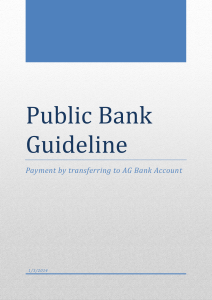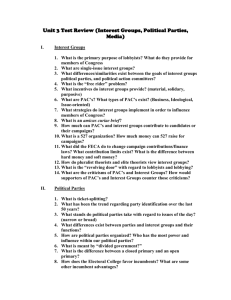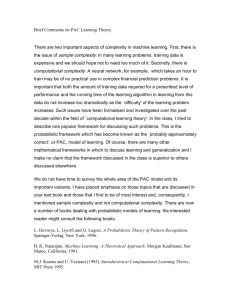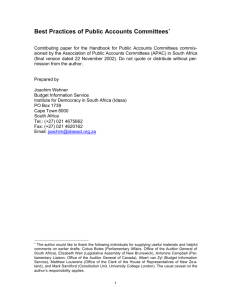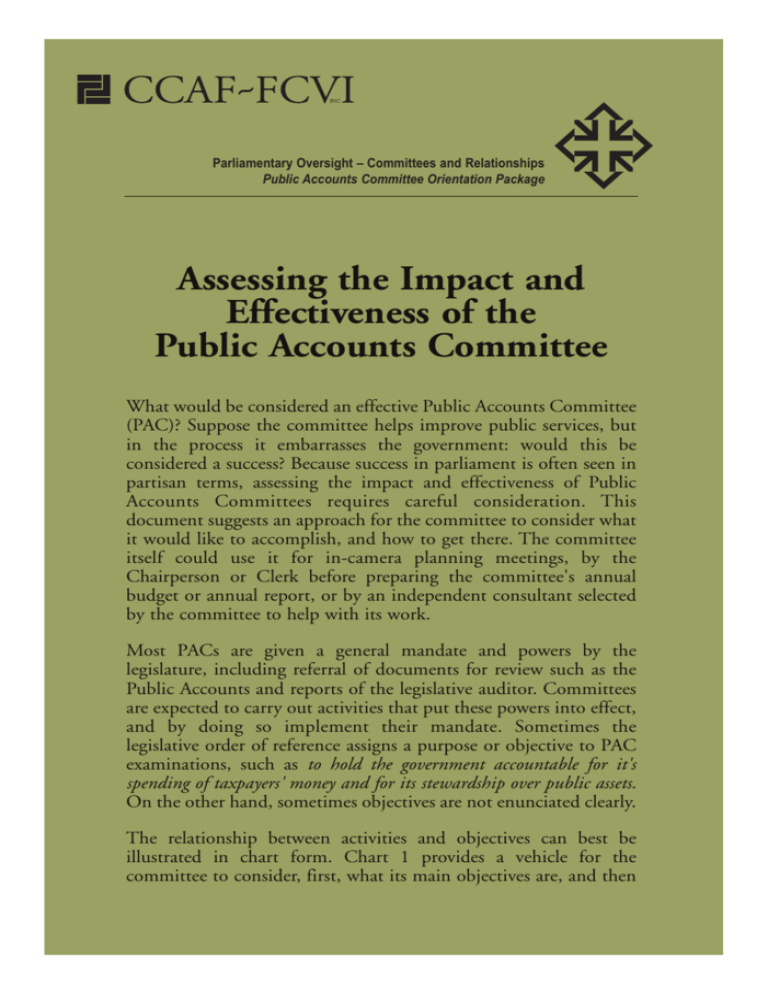
Parliamentary Oversight – Committees and Relationships
Public Accounts Committee Orientation Package
Assessing the Impact and
Effectiveness of the
Public Accounts Committee
What would be considered an effective Public Accounts Committee
(PAC)? Suppose the committee helps improve public services, but
in the process it embarrasses the government: would this be
considered a success? Because success in parliament is often seen in
partisan terms, assessing the impact and effectiveness of Public
Accounts Committees requires careful consideration. This
document suggests an approach for the committee to consider what
it would like to accomplish, and how to get there. The committee
itself could use it for in-camera planning meetings, by the
Chairperson or Clerk before preparing the committee's annual
budget or annual report, or by an independent consultant selected
by the committee to help with its work.
Most PACs are given a general mandate and powers by the
legislature, including referral of documents for review such as the
Public Accounts and reports of the legislative auditor. Committees
are expected to carry out activities that put these powers into effect,
and by doing so implement their mandate. Sometimes the
legislative order of reference assigns a purpose or objective to PAC
examinations, such as to hold the government accountable for it's
spending of taxpayers' money and for its stewardship over public assets.
On the other hand, sometimes objectives are not enunciated clearly.
The relationship between activities and objectives can best be
illustrated in chart form. Chart 1 provides a vehicle for the
committee to consider, first, what its main objectives are, and then
how it would like to achieve them; that is, how to get from the
bottom to the top of the chart.
The question to ask throughout the exercise of preparing this logic
chart is: how would one assess whether the committee's work makes
a difference? For example, if the committee reviews audit reports,
what value does it add? If the committee's review leads to a report
with recommendations, are they implemented? And if so, how does
implementation of recommendations improve public services?
Trying to answer these questions could develop a clearer sense of
purpose for the committee, and hopefully lead to a win-win strategy
for all parties. But even if not, a frank airing of all points of view
should lead to a more constructive atmosphere and deliberations.
In the following section, there are definitions of the main terms
used in this document and in the logic chart. Following each
definition are some questions that may help the committee work
through the steps from inputs to outcomes in a logical sequence.
1. Inputs are the knowledge, skills and experience of PAC
members, staff and witnesses, as well as any contributions of
media and others who follow the committee's work. Some
questions about inputs:
Does the committee have the necessary knowledge,
ability and commitment to carry out its activities and
achieve its objectives? If not, what steps could be taken
to improve?
Does the committee have the information it requires
to carry out its activities? If not, what steps could be
taken to obtain this information?
2. Activities mean what the committee actually does, such as
holding hearings that review the Public Accounts or the
legislative auditor's report; or analyzing the variances in the
performance report of a department; or obtaining
information from the public or from expert witnesses about
government's performance; following up to see whether
action has taken place; or giving interviews to the media.
Activities often use words ending in “ing” (such as
questioning, writing, obtaining or reviewing). Activities
carry out or put into effect functions, powers, roles and
responsibilities. Questions about activities:
What are the committee's most important functions
or activities? Why? Do some activities support
particular objectives more than others?
Is the PAC actually doing something to carry out each
of its responsibilities? What else could it do?
Would it achieve more results if it did more work e.g.
reviewing more chapters of the Auditor's report?
3. Outputs describe what happens during or immediately
after the committee's activities, such as the publication
of news articles; committee reports with conclusions or
recommendations to improve government performance;
commitments from the government to correct problems;
assurance or independent verification that corrective action
has taken place. Sometimes simply announcing an inquiry
into a subject may be sufficient to cause the government to
act - a government announcement could be an output (or
perhaps even better, an outcome), and it could happen even
before the committee holds a hearing. A sample question
about outputs:
Can the outputs of the functions or activities
be counted or measured, either quantitzatively or
qualitatively?
4. Intermediate Objectives and Outcomes. Determining
outcomes, or impacts as they are sometimes called, is the
most difficult part of this process. They are what happens as
a result of the outputs; for example, what happens when the
committee's recommendations are implemented. There
could be many outcomes, some financial and others
program-based, some positive and others negative, and they
could be hard to determine and to measure. Some questions
about outcomes:
How would one know whether the government is
more accountable as a result of the committee's work?
What are the indications?
If the committee has a clear objective, do the
committee's activities and outputs contribute to it? If
not, the committee might want to re-examine either its
activities or its objectives.
Are PAC report recommendations implemented, and
if so, do they improve the delivery of public services?
How does one know?
Does the Legislative Audit Office measure the time it
takes to implement its recommendations? If so, has the
committee helped to speed up their implementation?
Has the committee drawn attention to weaknesses in
government systems or suggested improvements? Does
the government or the Legislative Auditor measure
improvements in these systems?
Does the government give the committee credit for
some of the changes it makes? (If so, this is a clear
indication of impact.)
Can some outcomes be measured quantitatively or
qualitatively, even if the committee's particular
contribution cannot be measured?
5. Final Objectives and Outcomes are statements of purpose,
and their longer-term benefits and tangible results, such as
holding the government to account for its actions, or
improving public confidence in government. It is useful to
try to identify some particular benefits or results, such as
improvements in program administration that save money
or make programs more effective. Questions relating to final
objectives and outcomes:
Are the roles, responsibilities and objectives of the
committee and the outcomes that it intends to achieve
clearly identified in legislation, standing orders or other
authoritative source? If not, are there some results the
committee can achieve or aim for that all parties can agree
on?
Do committee members understand the committee's
roles and responsibilities and the interests that they
represent? What happens when the interests of the
general public/taxpayer conflict with the interests of
committee members' parties or their constituents?
Once the committee has a sense of its results, has it
identified how to achieve those results better and taken
the necessary action to do so?
Chart 1:
What the Public Accounts Committee Does,
and the Outcomes of its Work
The following generic example of a logic chart is meant as a source of ideas for Public Accounts
Committees that do not have such a document, or would like to update or revise the one they now have.
It makes assumptions about the mandate and legal powers of a generic committee that may not be
appropriate to every circumstance. PACs are encouraged to use it as a reference point for preparing their
own document, bearing in mind these are only suggestions that must be reviewed for consistency with
particular legislative requirements and with the preferences and practices of each jurisdiction. This
particular example is based on material prepared by the PAC in the State of Victoria in Australia. We
thank all PACs for their co-operation in providing examples of reference documents to us.
Final Objectives
& Outcomes
Intermediate
Objectives
& Outcomes
Better government
performance & stewardship
Improved public
confidence in government
More accountable
government
Improved financial and management
systems & practices in the public sector
Implementation of
recommendations
Better informed
Parliament & public
Government/entity acceptance
of recommendations
Outputs
Committee reports &
recommendations
Independent assessments of
government operations
Media analysis and
reports
Activities
Public hearings
In-camera briefings
Press interviews
Skills & interests of
PAC members
Advice & opinions of general
public & PAC advisors
Government reports and
information
Inputs
This product is part of a package developed by CCAF-FCVI entitled Parliamentary Oversight - Committees and
Relationships ~ A Guide to Strengthening Public Accounts Committees. All rights reserved.
Please contact CCAF at info@ccaf-fcvi.com for more information.


